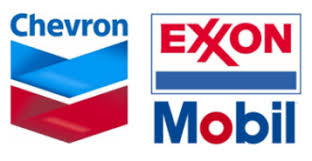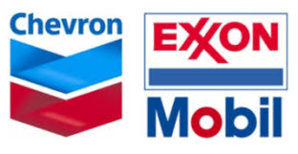Oil majors Exxon Mobil Corp and Chevron Corp have been plagued for more than a year by issues of lower margins and refining weaknesses which were cited as their reasons for lower profits.
The worst margins in its refining business on gasoline and some of the other profits that it had been making for a decade were cited to by the reasons for Exxon for its loss in its refining business since 2009. On the other hand, a 65 per cent drop in profits for its refining and chemical business was reported by Chevron.
The top line of both the companies was lower than Wall Street expectations and low than the numbers achieved by both in the year ago quarter because of weaker crude pricing.
The turnaround plans at the largest U.S. oil producer Exxon is yet to reap results as reflected by its 49 per cent fall in its first-quarter profit.
“It was a tough market environment for us this quarter,” Exxon Senior Vice President Jack Williams said on a call with analysts.
Exxon expended 42 per cent more year-on-year on capital investments for its shale and offshore operations as it continued to make heavy spending for increasing output. There has been pressure on oil companies to reduce spending and increase shareholder returns.
According to Refinitiv Eikon estimates, Exxon’s first-quarter profit dropped to $2.35 billion, or 55 cents a share compared to a year ago figure of $4.65 billion, or $1.09 a share. According to Refinitiv Eikon estimates, analysts had expected Exxon to earn 70 cents per share.
“Clearly, the corner is further away than we expected and we expect this to lead to underperformance in the near term,” analysts at RBC Capital Markets said in a client note.
The $33 billion bid for rival Anadarko Petroleum Corp was the focus of investors of Chevron instead of the earnings of the company that beat estimates. With a unsolicited, $38 billion bid for Anadarko, Chevron’s offer was sought to be derailed by Occidental Petroleum Corp.
They have started joint integration planning to combine the two companies, said Chevron Chief Executive Michael Wirth while talking to analysts. He however did not say anything about whether the company would be increasing its bid for Anadarko. He instead said that the company had signed agreement with Anadarko.
“We would not be surprised to see Chevron raise its offer,” wrote analysts at Edward Jones in a research note, saying they believed the company’s bid will “ultimately be the successful one.”
The U.S. shale business of Chevron achieved higher profits as its production rose which helped it to offset some of the fall in international oil and gas earnings. But its first quarter profits were negatively impacted by sharp declines in overall refining and chemicals business. It profits came at a $2.65 billion, or $1.39 per share, compared to $3.64 billion, or $1.90 per share, for the same quarter a year ago. Wall Street had expected $1.30 per share.
(Source:www.reuters.com)
The worst margins in its refining business on gasoline and some of the other profits that it had been making for a decade were cited to by the reasons for Exxon for its loss in its refining business since 2009. On the other hand, a 65 per cent drop in profits for its refining and chemical business was reported by Chevron.
The top line of both the companies was lower than Wall Street expectations and low than the numbers achieved by both in the year ago quarter because of weaker crude pricing.
The turnaround plans at the largest U.S. oil producer Exxon is yet to reap results as reflected by its 49 per cent fall in its first-quarter profit.
“It was a tough market environment for us this quarter,” Exxon Senior Vice President Jack Williams said on a call with analysts.
Exxon expended 42 per cent more year-on-year on capital investments for its shale and offshore operations as it continued to make heavy spending for increasing output. There has been pressure on oil companies to reduce spending and increase shareholder returns.
According to Refinitiv Eikon estimates, Exxon’s first-quarter profit dropped to $2.35 billion, or 55 cents a share compared to a year ago figure of $4.65 billion, or $1.09 a share. According to Refinitiv Eikon estimates, analysts had expected Exxon to earn 70 cents per share.
“Clearly, the corner is further away than we expected and we expect this to lead to underperformance in the near term,” analysts at RBC Capital Markets said in a client note.
The $33 billion bid for rival Anadarko Petroleum Corp was the focus of investors of Chevron instead of the earnings of the company that beat estimates. With a unsolicited, $38 billion bid for Anadarko, Chevron’s offer was sought to be derailed by Occidental Petroleum Corp.
They have started joint integration planning to combine the two companies, said Chevron Chief Executive Michael Wirth while talking to analysts. He however did not say anything about whether the company would be increasing its bid for Anadarko. He instead said that the company had signed agreement with Anadarko.
“We would not be surprised to see Chevron raise its offer,” wrote analysts at Edward Jones in a research note, saying they believed the company’s bid will “ultimately be the successful one.”
The U.S. shale business of Chevron achieved higher profits as its production rose which helped it to offset some of the fall in international oil and gas earnings. But its first quarter profits were negatively impacted by sharp declines in overall refining and chemicals business. It profits came at a $2.65 billion, or $1.39 per share, compared to $3.64 billion, or $1.90 per share, for the same quarter a year ago. Wall Street had expected $1.30 per share.
(Source:www.reuters.com)






